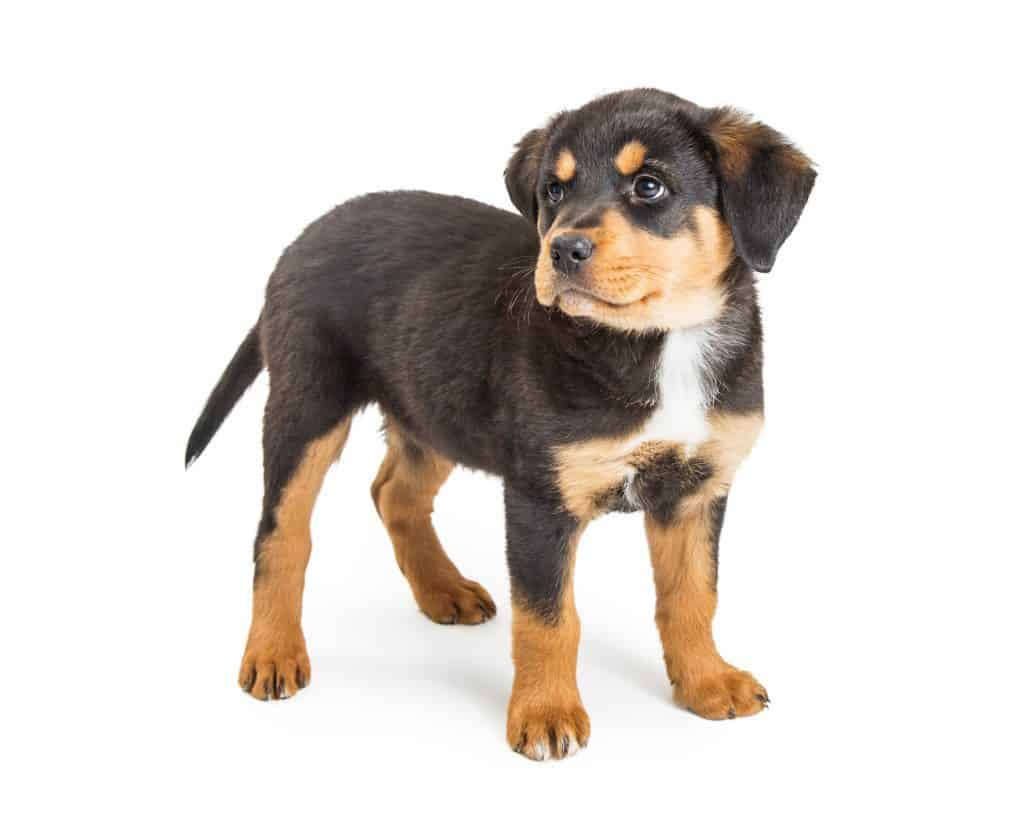Mini Rottweilers: Everything You Could Want to Know
Big dogs are great, but there is something special about having a smaller dog. It is possible to have the best of both worlds. Mixing one of America’s favorite dog breeds, the Rottweiler, with smaller dogs gives us the Miniature Rottweiler.
“Miniature Rottweilers” are not a recognized breed. It is impossible to find a healthy “purebred” Mini Rott. However, there are ways in which experienced and safe breeders can breed a Rottweiler that is a little smaller than average.
This post will tell you everything you need to know about the Miniature Rottweiler, myths, what they are, what they aren’t, and what to consider when buying a mix of this dog.
Miniature Rottweilers
When looking into making a Miniature Rottweiler a part of your family, it is important to know as much as you can. There are both safe, and unsafe ways in which this dog can be created. This post will look over both of those so that you can know everything about this new type of dog.
Miniature Rottweilers do not exist as an official breed and dogs who are sold as “Mini Rottweilers” do not receive recognition through the AKC
There are several types of “Mini Rottweilers” out there so it is important to define what exactly what we are talking about. There are:
- Purebred Rottweilers with Dwarfism – These dogs have health problems
- Rottweilers who are bred from runts of the litter – These “Mini’s” also have health struggles
- Rottweiler mixes – The healthiest Rottweiler you can get. They are called Mini Rottweilers and are also known by their mix breed names.
Dwarfism
You might see on other websites or in adds that people are selling “purebred” miniature Rottweilers. This is not true. For these dogs to be purebred there has to be something they are not telling you.
Often “purebred” mini Rotts have a gene called Dwarfism. This is a medical condition also known as Achondroplasia. It is a gene that gives dogs short limbs due to deficiency in growth hormones.
In Rottweilers this gene is often seen not only in the short limbs, but they have over-sized heads. Some other symptoms a dog with Dwarfism might show include:
- Swollen stomach or abdomen
- Feet turned outward
- Bulging eyes
- Swollen joints
- Lack of teeth
- Growing at slower rates than normal
- Snoring
- Hair loss
This gene can cause chronic health issues, such as pain with skeletal disorders. This dog will be a very expensive dog, due to ongoing treatment and many orthopedic surgeries. It can lead to serious spinal problems and even eye disorders later in life.
The deficiency in the growth hormone can also cause kidneys to not fully develop leading to renal failure.
If you are buying a dog with this dwarf gene, there is a chance that your breeder will not tell you about it due to the high medical expenses this dog is going to demand during their life.
Rottweilers as Runts
Another way that many people claim to have a “purebred” Mini Rottweiler is by breeding the runt of a litter with another runt of a litter. This is less common, because most of the time, however not all of the time, runts that survive catch up to the size of the rest of their breed.
Runts by nature are smaller than the rest of the puppies they are born with. If these dogs are taken care of properly they can survive to become adult dogs. The runts that don’t catch up with the rest of their breed in size as adults are used in breeding, in order to create another small Rottweiler.
This again is not a foolproof approach, runts in all breeds, in all types of animals struggle to stay alive while they are pups. Being a runt comes with a lifetime full of health challenges and problems.
Their bones are often weaker than a normal puppy and because of this, they are unable to function as other dogs in there breed do. They are unable to do as much physical exercise as they need to, and without another breed mixed with them, these Rott’s need their physical exercise.
They are prone to becoming overweight if they don’t get as much exercise as they need.
Which could be another issue in itself. If these dogs have weak bones, being overweight could lead to even more immobility. When puppies are born as small as many runts are, they struggle to survive, often times these pups don’t make it to six weeks.
Being a runt causes a potential for a compromised immune system. Again, choosing this dog can mean choosing a lifetime of health problems and medical expenses.

Commonly Bred Mixes to Create a Healthy Mini Rott
- Rottweiler/Miniature Pinscher Mix
- Pug/Rottweiler Mix
- Rottweiler/Chihuahua Mix
- Rottweiler/Beagle Mix (Reagle)
- Rottweiler/Poodle Mix (Rottle/Rottie Poo)
Many people absolutely love the appearance of their Rottweiler, but it may be too big for some. This is why the most common mixed breed for a Miniature Rottweiler is a cross between a Rottweiler and a Miniature Pinscher.
These dogs are essentially identical in color, so breeding them does not change their color. The biggest difference from each breed that is recognized when these breeds are mixed is their size.
Miniature Pinschers are very small dogs, while Rottweilers are very large dogs. The difference in size makes a great medium sized dog usually.
Typically this cross is small in height like the Mini Pinschers, and more filled out like a Rott. The pup will also have more of a rounded face and fluffy looking body.
Mini Pinchers are typically around 10 pounds when full grown, and the Rottweiler is 100 to 130 pounds full grown.
As puppies, Mini Rotts are generally 10 to 15 pounds. When they are full grown they will be between 30 and 60 pounds. They stand a little over a foot tall when fully grown.
These dogs typically have the same temperament as Rottweilers. For this reason, it is important to socialize them while they are young. Having different kinds of people as well as different kinds of dogs around your Mini Rott is so necessary so they can overcome their innate instinct to be aggressive.
The Miniature Rottweilers are typically a lot easier to train than normal Rottweilers. Although Rott’s don’t give much trouble when training, these dogs are even more cooperative.
They are brilliant dogs, which makes them easy to train. They are smaller, which makes it easier to control them. They are quiet and have lower energy. They still act uneasy around people they don’t know at first, but with proper training, this problem can be eliminated or adapted to.
Poor training is a major cause of aggression found in Rottweilers. Either learning yourself or asking someone to assist you in training can make your Mini Rott the ideal combination of protective yet friendly.
Other Mixed Breed Miniature Rottweilers
There are many other ways that breeders have found that produce a Miniature Rottweiler. This is typically done by crossing a smaller breed with a healthy full sized Rottweiler.
Pug Rottweiler Mix:
The Pug Rottweiler mix is another extremely common way to get a Mini Rott. These dogs typically exhibit the color of the Rottweiler while showing the size and body shape of a pug.
Pugs are typically a little under a foot tall and they weigh about 20 pounds. These numbers will be very similar in the Pug Rottweiler mix.
These dogs have the personality of a Rottweiler, so again it is important to socialize them almost immediately after you bring them home.
A downside to this mix of dogs is that they will shed like crazy. Pugs shed all of the time, and Rottweilers have two main shedding periods. It will be especially important to watch their fur and groom them during those two times during the year.
Healthwise these dogs are golden. Health concerns that might be more obvious in these two individual breeds are less likely to occur by mixing these dogs together.
The Rottweiler Chihuahua Mix:
This mixed breed looks less like the Rottweiler, so if you are looking for a small Rottweiler looking dog, this one might not be the one for you.
This mix tends to be even smaller than the other mixes listed. Chihuahua’s are very small dogs, so that gene kicks in and can really bring down the size of this mixed pup.
A problem to look out for is the fact that both the Chihuahua and the Rottweiler are aggressive dogs. This can cause a mix of them to also be very aggressive.
This mixture of dogs is probably the most important for you to socialize from a young age.
Chihuahua’s are aggressive in a much different way than Rottweilers. Their small size is a little bit deceiving sometimes. We have all seen a Chihuahua that won’t stop barking and look and act like if they were a little bigger they would attack you.
Well, make that Chihuahua bigger and there you have the Rott Chihuahua mix. That is why socializing them is so important.
After Rott’s are comfortable around you, they back off and don’t go into defense mode as easily. Trying to channel this trait at a young age is vital and will make your pup a little friendlier to be around.
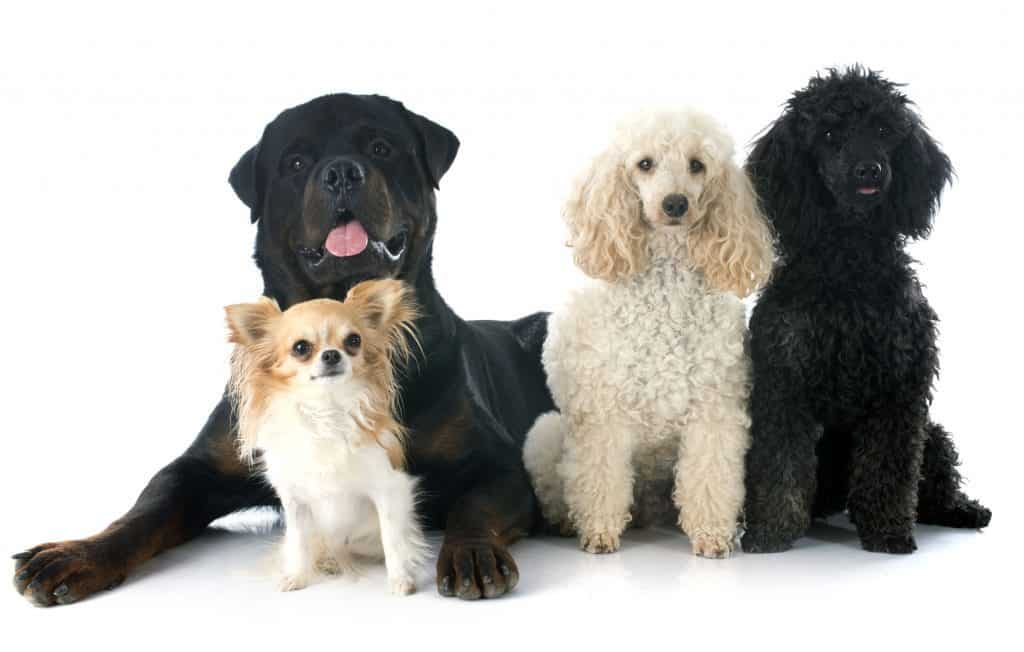
The Rottweiler Beagle Mix (Reagle):
This mix is bigger than most of the other ones listed. This dog is more of a medium to large dog. It is not as big as the purebred Rottweiler, but it is still a little bigger than the Rott Chihuahua mix. It typically weighs between 50 and 85 pounds when full-grown and stands 15 to 27 inches tall in adulthood.
The Reagle has the coat of the Rottweiler, but the body shape of the Beagle. This makes a pretty cute dog, having the ears and face shape of the Beagle with the Rottweilers beautiful coat.
This dog is very friendly and loyal. It requires the same need for socialization that other Rott mixes do, but because the loving beagle is apart of it, warming up to people comes quicker and easier.
This mix of dogs does very well with families, especially those with small children. It is playful and loves being around people.
The Beagle uses his nose and sense of smell as his strongest sense. This trait carries over to the Reagle.
Reagles don’t require a ton of physical exercise. They are perfectly happy sitting at home with their family. This is nice for people who do not have a lot of land or space for their dog to run around. Of course, they still need exercise, but not as much as a normal Rottweiler.
The Rottweiler Poodle Mix (Rottle):
The Rottle or Rottie Poo has the potential to be near the top of America’s favorite dogs because both the Rottweiler and Poodle are among America’s favorite breeds.
Rottle’s have a pretty large range in size, but typically they weigh between 75 and 100 pounds and are 20 to 25 inches tall when fully grown.
They have an absolutely beautiful coat. Their color typically takes after the Rottweiler. The poodle works itself in there though, with thick curly fur.
This mix will hardly shed. Poodles do not shed very much, and Rottweilers shed during two times of the year. Due to the fact that their coat type and texture takes after the Poodle, that will prevent shedding.
This dog is a little more difficult to groom. A Poodle’s coat is very high maintenance, so careful care is required.
Depending on how you want to keep your Rottle’s coat, you will either need to cut his or her fur every other month or so, or brush their fur daily. This is a small price to pay for the beauty of their coat.
It is important again to socialize this dog. They will be playful and loving around people he or she is comfortable with, but around strangers, the Rottle can be defensive, protective, and even at times aggressive. As you socialize this dog, make sure that you include children.
From the time they are puppies, they must be comfortable around children so they can get used to them and don’t respond or react in a poor way around kids.
They are larger dogs so it is smart for you to be with your small children when they are with your Rottie Poo, but teaching and training them can help them be more calm and careful with children.
Caring for a Miniature Rottweiler
Caring for these pups will be unique depending on the mix, however, there are some universal tips that are important to consider for taking great care of your Mini Rott.
Since the common factor in each of these dogs is that they are all part Rottweiler, caring for a Mini Rott can be similar to caring for a purebred Rottweiler.
Exercise
All Rottweilers need a good amount of exercise. Pure bred pups require much more than these mixes, but it is important that your mini Rott can spend at least 30 minutes outside each day.
Grooming
Grooming is another huge aspect of taking good care of your Mini Rott. Earlier in this post, I talked about different breeds that might need more attention given to this important part of caring. It is important that all Rottweilers are groomed. Their fur is typically very thick and so because of that, they need to be brushed often.
Depending on the breed, it is not necessary to bathe often or cut their fur, but your vet or groomer will know more about your individual pup and what will be best for grooming him or her.
Clipping their nails and checking the skin around their feet is important as well, especially if they have access to an open field or a ground surface you aren’t completely familiar with.
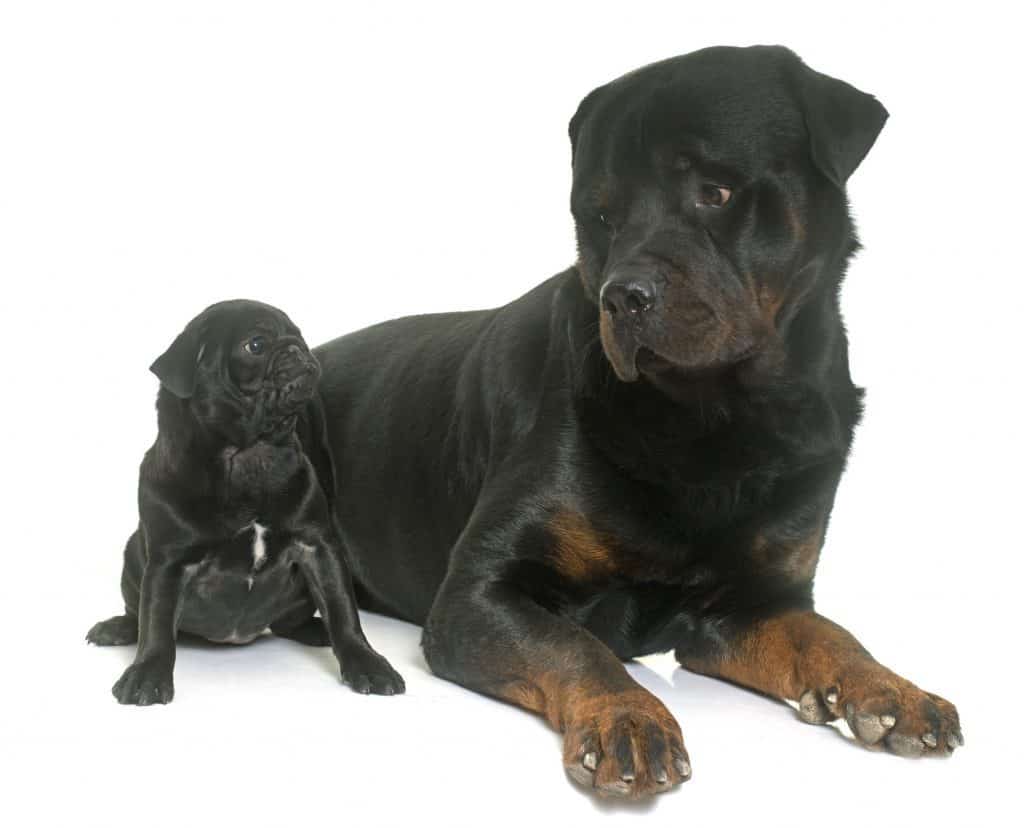
Diet
Food is a huge and very, very important part of your Mini Rott’s life. Choosing the right food will contribute to so much of how they live.
When looking at foods it is best to look for foods that have a lot of protein, since Rott’s need about 22-28% of their diet to be protein.
Make sure that you buy food that is specifically for miniature breeds. This will have nutrients specifically for helping them grow in the way they should and in the places they need it most.
It is important to monitor your pup’s food intake.
Rott’s are notorious for eating too much and becoming overweight. Especially if the mix you are looking at isn’t a very active dog, watching their food intake should be a priority. This is due to the fact that it will most likely carry the Rottweiler’s eating habits and weight gaining tendencies over to the mixed breed.
Training/Socialization
One of the most crucial, if not the most crucial thing you can do for your Mini Rott is socializing them. A Rottweilers instinct and drive to be protective and aggressive is its most dominant gene. It will most likely carry over into any mix you have.
Taking your dog to a dog park once or twice during the week is a great way to help them socialize with other dogs.
It is extremely important to have your Mini Rott be around as many people as possible, including and especially children (if they will be raised in a family with small kids).
Rottweilers love their family, and once they are comfortable with someone they are playful and kind, but until they know a person they may act very defensively towards any people they don’t know or a specific person that they haven’t had a great experience with.
Keeping them well acquainted with new people from the beginning will break down their defensive barrier a little bit.
Cost of Miniature Rottweiler
Depending on the type of dog you want a Rottweiler mix with, the prices will vary. It will also depend on how easy or difficult it is to breed the two dogs, as well as the individual breeder.
Each breeder is different and will have different prices. This may be a result of shots given or not given to the pups as well as where they live. These numbers are averages of some prices listed.
| Mixed Breed | Rottweiler Cost | Other Breed Cost | Mixed Breed Cost |
| Rottweiler Miniature Pinscher Mix | $850 – $1,500 | $500 – $1,200 | $300 – $1,000 |
| Rottweiler Pug Mix | $850 – $1,500 | $600 – $1,500 | $1,000 |
| Rottweiler Chihuahua Mix | $850 – $1,500 | $400 – $1,000 | $500 – $1,000 |
| Rottweiler Beagle Mix (Reagle) | $850 – $1,500 | $400 – $1,000 | $800 – $1,200 |
| Rottweiler Poodle Mix (Rottle or Rottie Poo) | $850 – $1,500 | $1,200 – $2,000 | $1,000 – $2,000 |
Appearance of Miniature Rottweiler
The appearance of your Mini Rott will likely depend on which other breeds it is a mix between. However, the majority of mixes tend to take the color of the Rottweiler while the other dog’s body shape is more obvious.
The appearance will always be a gamble. There is a chance every time a dog is bred that it will look like either parent. Knowing what the parents look like can help you know what your Mini Rott could look like. Most likely your pup will be the basic colors that purebred Rottweilers are.
Rottweilers are very large dogs, and so chances are that your mini Rott will be much smaller than a normal Rottweiler but they won’t be as small as another toy or mini breeds.
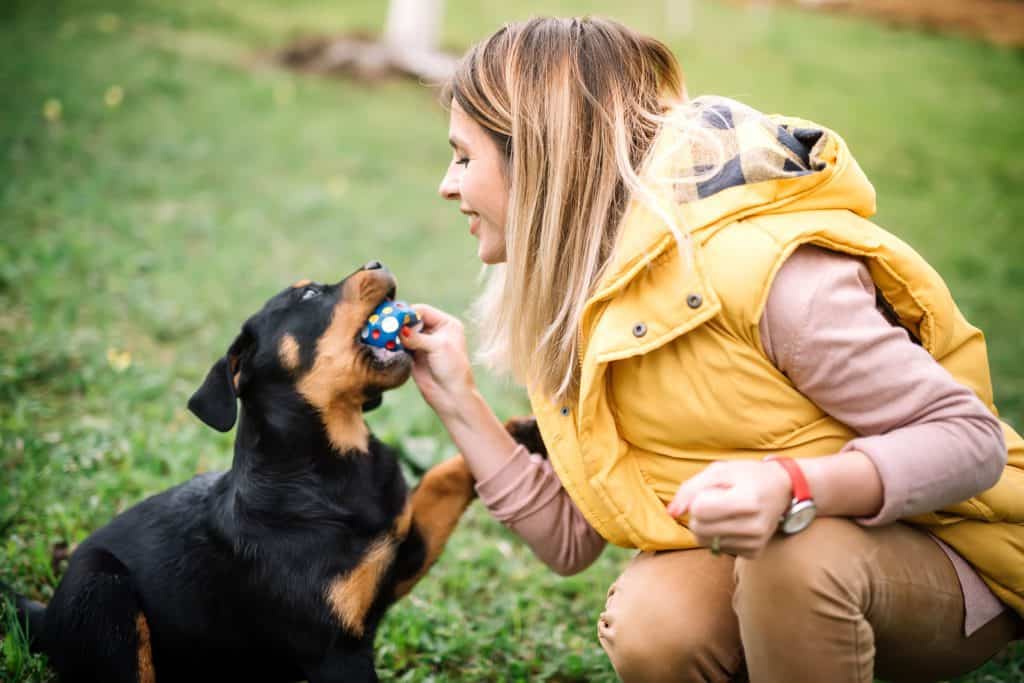
Mini Rottweiler vs. Normal Full Grown Rottweiler
There can be benefits for owning both Mini and purebred Rotts. While each has similar Rottweiler traits, they are individual and have specific characteristics unique to them.
Miniature Rottweilers don’t require as much space as purebreds. Since they are typically mixed with a breed that is much less active than they are.
If you want a Rottweiler but don’t have a big backyard or place for them to run around, a Mini might be better for you. This breed even does well inside apartments and small houses.
They do not require as much attention as larger dogs. Purebred Rotts don’t ever want to be left alone, they will follow you around, while the miniature breeds aren’t quite as dependent on human interaction.
Their size also helps in training, because they are smaller training becomes easier. This can be nice especially if you don’t get your dog as a puppy. You will still have control over their size as you train them in basic skills.
Mini Rotts are a great family dog, especially for families with small children.
Buying a purebred Rotts can sometimes be a toss-up when it comes to children since they have innate instincts to be aggressive. Even though Miniature Rottweilers still may have these instincts, they are much smaller and much less dangerous to children.
It is still very important to train your miniature Rottweiler as you would your purebred, full-sized Rott, but these dogs’ size makes it a little bit less of a safety risk if you don’t train them as well.
Mini Rottweiler Breeders
Here are a couple of really great breeders that are experienced and know how to properly breed mini Rottweilers to be healthy and ready to go to your homes.
- Countryside Puppies
- Greenfield Puppies
Countryside Puppies
These breeders have been breeding Miniature Rottweilers for over 10 years. Their miniature Rotts started as a mix of Pekingese and Miniature Pinscher, later a Pug was introduced. Then they brought a Rottweiler into the mix and the product was a miniature Rott.
“The miniature Rottweilers that I breed are not meant to disrespect the registered Rottweiler nor are they to line my pockets with gold. They are meant for people that live in small houses or apartments or for older people that after having Rottweilers all their life don’t have the energy to train and take care of a big dog.”Chris, Countryside Puppies
Their dogs are 30 – 35 pounds. They come with their first set of shots done as well as being dewormed 3 times.
They want the best for all people and puppies. They breed and raise their puppies in a loving environment. They are in Lancaster County in Pennsylvania. For more specific details about their pups, you can visit the Countryside Puppies website.
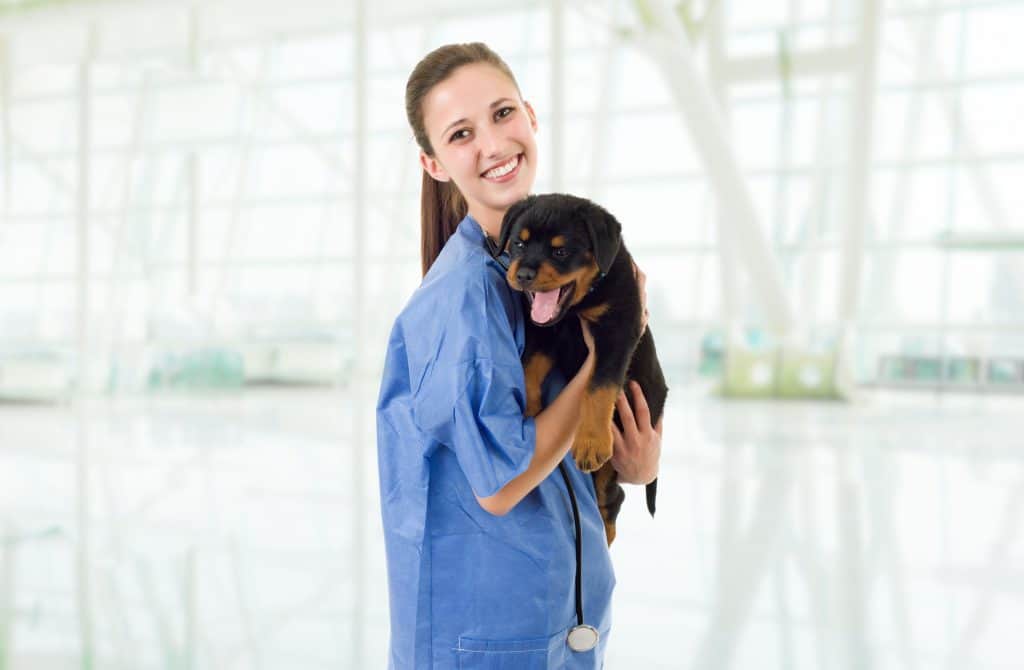
Greenfield Puppies
This is a website that works with many local breeders in the Pennsylvania area. They have a wide variety of Mini Rotts because they work with more than one breeder.
This website is very easy to navigate and they provide a lot of really great information about their puppies. This information includes:
- Date of Birth
- Gender
- Age
- Availability Date
- Information on Parents
- Price
They do a very good job to make sure their breeders are ethical and have the puppies needs in mind. There website can be reached here.
Tips for Buying a Miniature Rottweiler
Choosing the right dog is very important, especially when choosing mixed breeds. If what you are looking for is a smaller version of a Rottweiler, then it is important to look at all of your options.
Think about which breed you want to have a Rott mixed with. Each breed has individual traits and characteristics that are important to consider. Here are 4 tips to consider when looking into buying a miniature Rottweiler.
1. Do your research
Learn as much as you can about the different kinds of miniature Rottweilers out there. You want to make sure that you are getting the one that is best for you. Also, do your research on Rottweilers in general. You can never have too much information before buying a new pup.
2. Cheaper is not always better
Although it may be tempting to look for the cheapest dog out there, this is not always wise. Dogs are expensive and if you find a dog that costs less money, there are chances that it has some other expenses or reasons that it is less money than others of its breed.
3. Stay away from Dwarfs and Runts
As mentioned earlier in this post, dwarfs and runts are ways that some breeders go about creating a “purebred” miniature Rottweiler. These dogs will have many medical expenses in the future, and could potential be in a good amount of pain their whole life. Breeding these dogs specifically for there size, isn’t the most ethical thing that a breeder could do.
4. Get as much information from your breeder as you can
When you do find the mini Rott that is right for you, it is important to look at and understand the medical history not only for your puppy but for both parents. This can help you know how to proceed with your vet and new pup as well as look out for any health concerns the future could potentially bring.
These pups will make a great addition to your family. They are friendly and loving and have all of the great qualities and looks of a Rottweiler in a smaller package.
